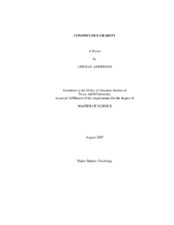| dc.description.abstract | With the increased number of natural disasters that have plagued the world in
recent years, benefits and charities have become forefront in the media and in people’s
minds. The most publicized of these charities are ones that invoke the names and the use
of celebrities. I intend to discuss how works of charity and philanthropy can be
conceptualized as consumption of cultural capital, and how these works can be
interpreted in some cases as merely an expedient way to gain social capital or higher
social standing within society. Even though this use of munificence has been
traditionally frowned upon, I will use Thorstein Veblen, David Riesman, and other social
theorists to argue that such misuse is universal and trans-historical. It is important to
question the historical and current motivations behind philanthropic or charitable
participation, especially by those who can be labeled the socially powerful, because their
actions are emulated by the rest of society.
Understanding the motivations behind giving is becoming progressively more
important for two reasons. First, contemporary society is becoming increasingly more
celebrity oriented where recognition is due to conspicuous social status, as opposed to
what you have done. Due to this fixation on fame, celebrities influence many aspects of society, including people’s very behavior. The second reason motivations should be
explored and questioned is that the incentives behind giving have not previously been
explored in-depth, and therefore charity can not be adequately understood. The
amalgamation of these two subjects into one topic is in itself important. By doing such, I
bring a new perspective to the discourse on celebrity and of giving.
This question also needs to be asked since understanding who these people are,
and historically were, and why they give to charity, is to understand what charity is, and
has evolved into. If givers’ motivations are not properly examined, giving may become
just another empty gesture in a multitude of empty gestures, as they are depicted by Jean
Baudrillard and other postmodernists. | en |


